Torticollis: Physiotherapy Treatment
Table of Contents
What Is Torticollis?
Torticollis is a condition that refers to a neck condition that causes the head to lean to one side. The muscles on one side are shorter than the other, causing the head to tilt towards the short muscles. There are many causes of torticollis, but the most common cause is an injury to the neck, usually from a car accident or another injury. Other causes include spasmodic torticollis or muscular dystrophy.
- It is a problem involving the neck muscles this causes is the head to tilt down.
- It , is a dystonic condition which is defined as a by an abnormal, asymmetrical head or neck position, which is due to a variety of causes.
- This word term comes from two Latin words: torus- twisted, and column – neck.
- It is also called “wry neck.”
- This condition is present in baby at birth, it is called congenital muscular torticollis. it is most common type.
- This condition is also develop in Babies after birth. it is called “acquired,” it is linked to other,& become more serious for medical issues.
- Most common case is no obvious cause & pain and difficulty in turning the head .
- The top of the head is tilted to one side while the chin tilted to the other side.
- It is the result of damage to the neck muscles or blood supply.
- Debilitating pain and difficulty performing daily tasks is by Chronic Torticollis .
- Relieve pain and stiffness is relieve by medications and therapies .
- Sometimes correct the condition is by Surgery .
Anatomy related to Torticollis :
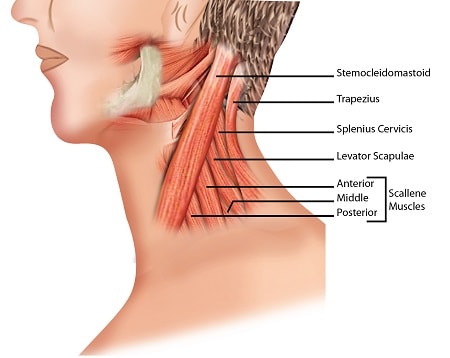
- The anatomical cause of torticollis is a shortened sternocleidomastoid muscle.
- It is a muscle of the neck.
- Origin of sternocleidomastoid muscle. = at the sternum and clavicle
- Insertion of sternocleidomastoid muscle. = same side on the mastoid process of the temporal bone .
- Two sternocleidomastoid muscles are in the human body & when both are contract, the result is fleaxtion of neck .
- Blood supply of sternocleidomastoid muscle. = transverse scapular artery , transverse cervical artery superior thyroid artery,occipital artery .
- Cranial nerve XI (the accessory nerve) is innervation of these muscles .
- The second, third and fourth cervical nerves are also involved in this muscle .
Classification of the Torticollis :
Congenital torticollis :-

- The most common torticollis is which is present at birth known as the Congenital muscular torticollis.
- The cause of this torticollis is unclear.
- In the neck the cause of damage to the sternocleidomastoid muscle is birth trauma or intrauterine malposition .
- Other think is to the muscle tissue arise from repetitive microtrauma within the womb or a changes in the calcium concentration in the body this is causes of prolonged period of muscle contraction.
- Decrease the range of motion of rotation and lateral bending by the result of the shortening or excessive contraction of the sternocleidomastoid muscle
- Tilted or lateral bending the head is to the affected muscle side and rotate the opposite side.
- In second words, tilted the head is direction of the shortened muscle and the chin tilted in the opposite side .
- It is present at 1– 4 weeks of age and a mass [ hard ] develops.
- It is diagnosed by using , color histogram or the infant’s passive cervical range of motion to evaluating , ultrasonography .
Acquired torticollis :-
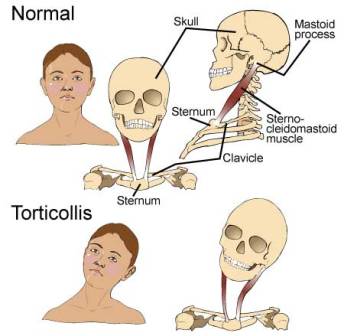
- Non congenital muscular torticollis is result from scarring
- Disease of cervical vertebra
- Adenitis .
- Tonsillitis .
- Rheumatism, enlarged cervical glands .
- Rtropharyngeal abscess,
- Cerebellar tumors.
- It is may be spasmodic (clonic) or permanent (tonic). after it is occurs due to tuberculosis of the spine [ Pott’s Disease ] .
- Torticollis occurring form one or more painful neck muscles after that stiff neck’ and it will pass to spontaneously in 1–4 weeks.
- In torticollis involved the sternocleidomastoid muscle or the trapezius muscle.
- Other cause is the Tumors of the skull base it can compress the nerve supply to the neck .
- Infections in the posterior pharynx it is also cause torticollis .
- In cause torticollis in drug like as anti psychotics .
Types of torticollis :
Temporary torticollis :
- This type of torticollis disappears after one or two days.
causes :
- A cold
- Swollen lymph nodes
- Infection of ear
- An injury of head and neck
Acute torticollis :
- It is also called Fixed torticollis or permanent torticollis .
- It is usually occur due to a problem in the structure of muscular or bone .
Muscular torticollis :
- It is the type of fixed torticollis.
- This is occurs due to or tight muscles on one side of the neck &results of scarring
Klippel-Feil syndrome :
- It is a rare, congenital torticollis.
- It occurs due to when the bones in the baby’s neck form incorrectly, because of that two neck vertebrae are fused to each other .
- Children born with the difficulty of hearing and vision.
Cervical dystonia
- It is rare disorder which is sometimes referred to as spasmodic torticollis.
- It causes of that neck muscles to contract in spasms.
- When the cervical dystonia present , head is twists or turns painfully to one side.
- Head is also tilt forward or backward.
- It can happen to anyone.
- Most commonly diagnosed in people ages of 40 to 60.
- Women are more affects than man .
What are the causes of torticollis?
Categories include :-
- CNS/PNS
- Oral ties (lip and tongue ties )
- Non-muscular soft tissue
- Spasmodic
- Drug induced
- Osseous
- Traumatic
- Ocular
Congenital muscular torticollis :-
- Before birth in the womb way of baby position .
- SCM muscle = abnormal development
- Muscle trauma or damage during delivery
- Upper cervical spine congenital bony abnormalities , such as shortened neck , dwarfism
- In the cervical spine abnormal rotation or subluxation of the C1 vertebrae over the C2 vertebrae which is compress the neck .
- Klippel-Feil syndrome
- Achondroplasia [ growth disorder of bone ]
- Mosquito syndrome,
Acquired torticollis :-
- Viral infection
- Head and neck minor trauma
- Soft-tissue & respiratory infections of the neck
- Cervical spine abnormalities (such as atlantoaxial subluxation)
- Ocular torticollis [ vision problems ]
- Certain medications of abnormal reaction = dystonic reaction
- Sandi fer syndrome
- Gastrointestinal reflex (GERD)
- Spasms nutans [ condition that head bobbing along with uncontrolled eye movements ]
What are the Symptoms of torticollis?
- Head tilts to one side with chin pointed to the opposite shoulder. In about 75% of babies, right side is affected.
- Head doesn’t turn side to side and up and down easily.
- Feel the soft lump in baby’s neck muscle.
- Normally inability to move head
- Stiffness or neck pain
- Headache
- One shoulder higher than the other
- Neck muscles swellings
- The faces of children appear flattened and unbalanced.
- Difficulties in hearing and vision or motor skill delays
- Neck pain
- Thick or tight sternocleidomastoid muscle
- Occasional formation of a mass
- Tremor in head
- Tenderness on the cervical spine
- Decreased neck movement
Tortocillis in baby :
- Some babies are born with head tilt .
- And some time develop a head tilt soon after birth.
- It is called torticollis.
- If baby is diagnosed with this condition, generally it is not permanent and can be relieve with the right treatment.
- In starting phase baby mostly does not feel pain, and this temporary condition need treatment for fully relief .
What Causes of the Infant Torticollis?
- In babies, torticollis is due to the womb position in the uterus.
- This is also occur during birth but it is rare mostly occur if the delivery is a breech birth delivery or a difficulty in first-time delivery.
- Baby is in an unusual position at birth, like as a breech position
- Forceps or vacuum delivery.
- Uterus was cramped for the baby
- During delivery trauma or damage of muscle
- Abnormal development of SCM muscle
What Are the Signs and Symptoms of Torticollis in baby ?
- Head of baby is tilt to one side
- Chin points the opposite side of head tilt
- Neck muscles are seen tight
- Baby looking over one shoulder not the turn to look the other way
- During breastfeeding, baby seen to one side or one breast
- In baby showing the frustration when baby unable to turn the head
- In baby may be develop a flat spot on his head because of that baby keep the head in the same position when sleeping .
- In baby may have a small lump, such as knot on the neck of the side of the contracted muscle.
How Is Torticollis Diagnosed in baby ?
- If in the baby suspect the torticollis, go to the healthcare provider.
- This condition is detected mostly after birth in the first six to eight weeks .
- In the examination of baby healthcare provider is check to see how far baby can turn her head, and search for a lump in the contracted SCM muscle on the baby’s neck.
- In some cases, baby provider to order X-rays to help identify this condition, or may be recommend take to baby to physical therapist, neurologist, or orthopedist for further treatment .
What Is the Treatment of infant Torticollis in baby ?
- Helping the baby do exercises to stretch the tight side of the neck.
- They help to loosen the tight SCM muscle and strengthening the weaker muscle on the opposite side.
- When baby in bed for a nap, put the baby to sleep on back for safe sleep in crib position with the torticollis side facing the wall.
- On This way must crane the neck in the opposite direction for order to see into the room.
- This may also involve the changing the position of the crib to give in the right position.
- During the day , position of baby in a way that stretch the neck in the opposite direction of head tilt.
- Try with toys or attracting the baby with fun sounds to try to baby for look this way.
- When baby in feeding time feeding like as bottle-feed or breastfeed of baby on this time encouraged to face in the opposite direction of the head tilt.
- In some cases when the any treatment have not worked after that use the surgery for lengthen the tendon to treat the torticollis.
Does Infant Torticollis Go Away?
- Follow the treatment plan which is recommended by the baby’s healthcare provider is help to baby’s torticollis relive .
- That it take up to six months for results and till to a year or longer time in some cases.
- The stretching exercises recommend by the healthcare provider are most effective when baby is between 3 and 6 months
Treatment of Torticollis :
- Some instances of Torticollis can disappear within a few days when the person rest & avoid move the neck.
Treatments for torticollis include:
- Ice packs for pain
- After that give to medication
- Use the physical devices for keep the neck fixed in place
- Massage therapy
- Physical therapy treatment
- Surgery
- Stretching exercises
Medical Treatment :
- Muscle relaxants .
- Anti-inflammatory drugs .
- This drug are given for spasmodic torticollis .
- This drug is effect on injury or as a side .
- Botulinum A toxin [ Botox ] .
- It is used in chronic neck muscle spasms & cervical dystonia,
- Also provide relief by preventing muscles from contracting.
- This is also prevent the condition from progress.
Surgery :
- It is used when the other forms of treatment does not work.
- In surgery surgeon cut the certain nerves and muscle for stop the muscle contracting.
- Around 10 % of children who have present torticollis from birth it is require to surgery for lengthen the SCM muscle in the neck.
- Surgery will do when the child reach in preschool age.
Brain stimulation
- It is a rare treatment option.
- In this technique doctor inserting a wire into the part of the brain for controls movement & disrupts the brain signals.
- It is help with cervical dystonia.
- People also try to treat the torticollis at home.
- Some remedies to help manage symptoms of pain and discomfort.
Other remedies include :
- Sleeping and rest because torticollis symptoms disappear during sleep, so rest & lying down help to decrease to symptoms a give to relief.
- Use the hot pack or ice pack. this devices are relieve the pain & smooth the tight muscles.
- Touch the opposite side of the , chin , neck or face
- Doing this trick of the body because this is help to stop spasm temporarily.
- Stress cause muscles to tighten and worse the torticollis symptoms. so Knowing the triggers stress point and use the stress-reduction techniques help to manage symptoms.
- Stretching exercises in These gradually try to move the head in the opposite direction, for many time this is help to improve motion and easy to discomfort.
Stretching of Torticollis apply at home :
Tilt your body forward :
- Stand with the legs apart and lean the body forward, and leaving the head hanging.
- Goal = allow to head and arms to be loose & you are stay in that position for about 2 minutes.
- In this act head weight use as a pendulum, which is increase the cervical vertebrae space & decrease neck muscles spasm.
- You can also move the head with small movements to one side but check the muscles of the shoulders and the neck are more relaxed
Apply pressure to the neck muscles :
- In This technique use the thumb for apply pressure to 30 seconds on middle of the muscle.
- Then you have also press the part where the muscles start , in the nape of the neck for another 30 seconds.
- During this treatment therapist in standing or sitting position & the head is facing forward.
Physiotherapy Treatment :
- It is important because it can help to stretch the neck this technique called muscular energy.
- In this technique place the hand torticollis side on the head & give to exerting force by pushing the head against the hand. Hold The position for 5 seconds & then relax, rest for another 5 seconds.
- Repeat the exercise 4 more times.
- Little by little range of motion will improve.
- After finish the exercise limitation movement you can repeat the movement to the opposite side.
- Means pain in the right side that put left hand on the head & give the force with the head& push the hand.
- Hold the force without take the head off for 5 seconds & then rest for another 5 seconds.
- This will stretch the muscles on the affected side .
Massage and compresses :
- For neck massage use almond oil or other moisturizer is a good way for decrease pain & discomfort.
- Massage is applied on the shoulder , neck & head .
- But it is applied in the last part of the treatment means after perform the exercises and techniques .
- Massage is not apply with a lot of force & use the palm for press the muscles of the neck, from the shoulders to the ears .
- Small silicone cups used with little pressure for increase blood flow & loose the muscle fibers.
- A warm compress is given on the neck, for 20 minutes.
Stretches of torticollis of baby [ Affected side is left ] :
Side bending :

- Lay down the baby on their back.
- Put the palm of baby [ left hand ] on the back of the baby’s head.
- Therapist put right hand on the baby’s left shoulder.
- Bend the baby’s right ear to the right shoulder.
- Press down on the baby’s left shoulder at the same time.
- Stop the pressing when feel tightness.
- Position hold = 30 to 60 seconds.
- Apply this stretch 3 more times during the day.
Rotating :
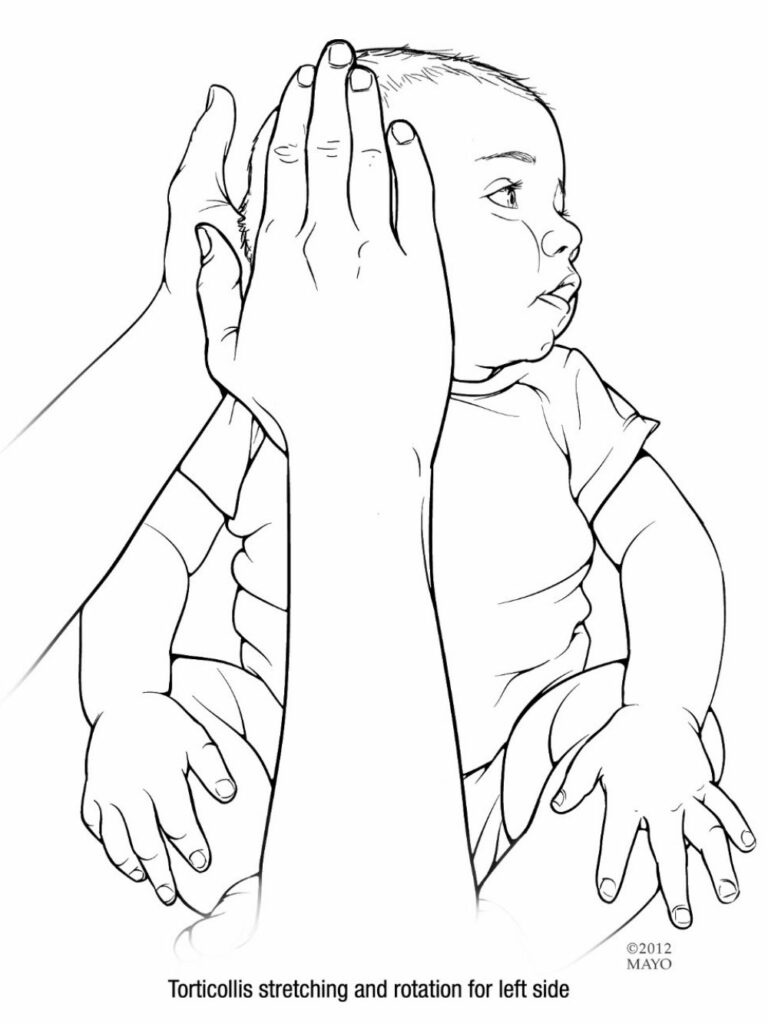
- Lie down the baby on their back.
- Put therapist their right hand on the baby’s right shoulder.
- Use therapist their left hand to turn the baby’s head gently to the left.
- Stop when you feel tightness.
- Hold for 30-60 seconds.
- Apply this stretch 3 more times during the day.
Positions :-
Positioning with activity :-
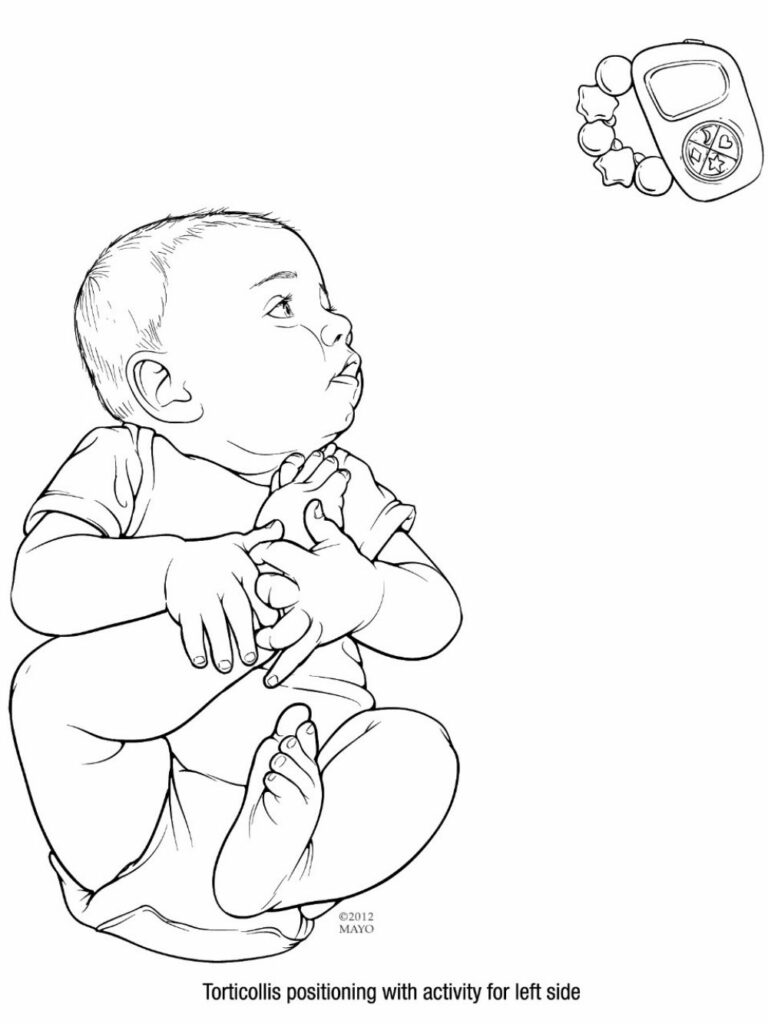
- Lie down the baby on their back.
- Put the colorful toys left on baby’s head & sit or lie in this area.
- Put the baby in this position often during a day.
Tummy time :-
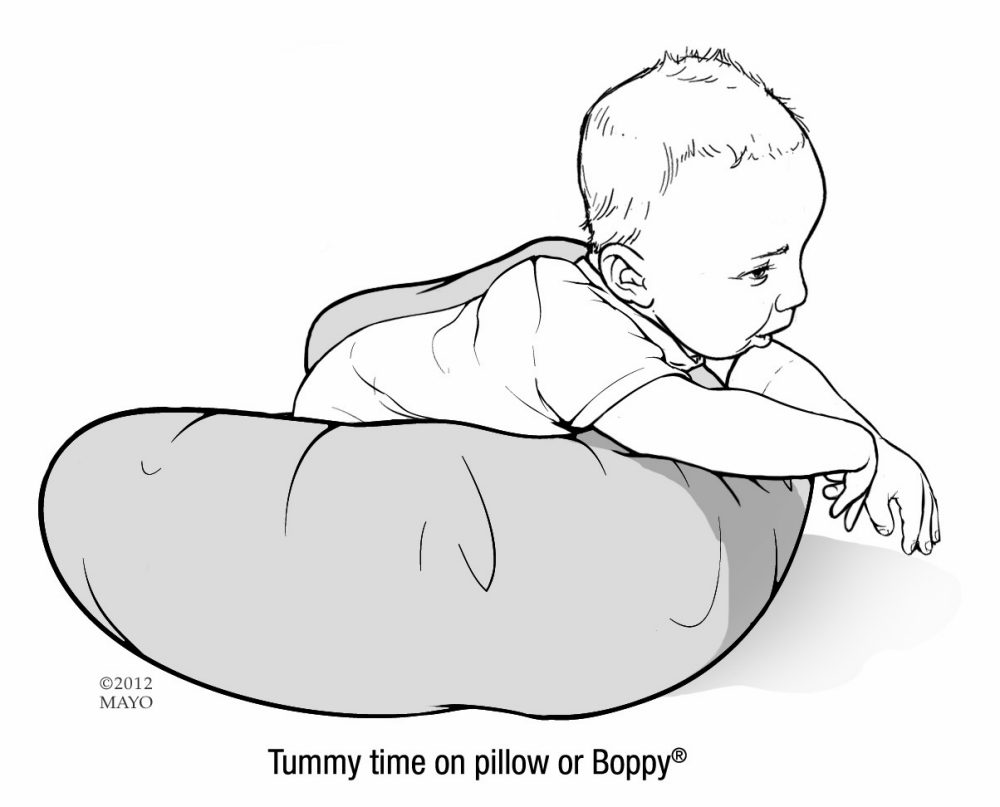
- Put the baby on their tummy.
- Put the toys on the baby’s left.
- Sit or lie in this area.
- This technique help the baby to look the left.
- Apply this position during the day.
Carrying the baby during Torticollis :-
- Carry person = holder
Main carrying position :-
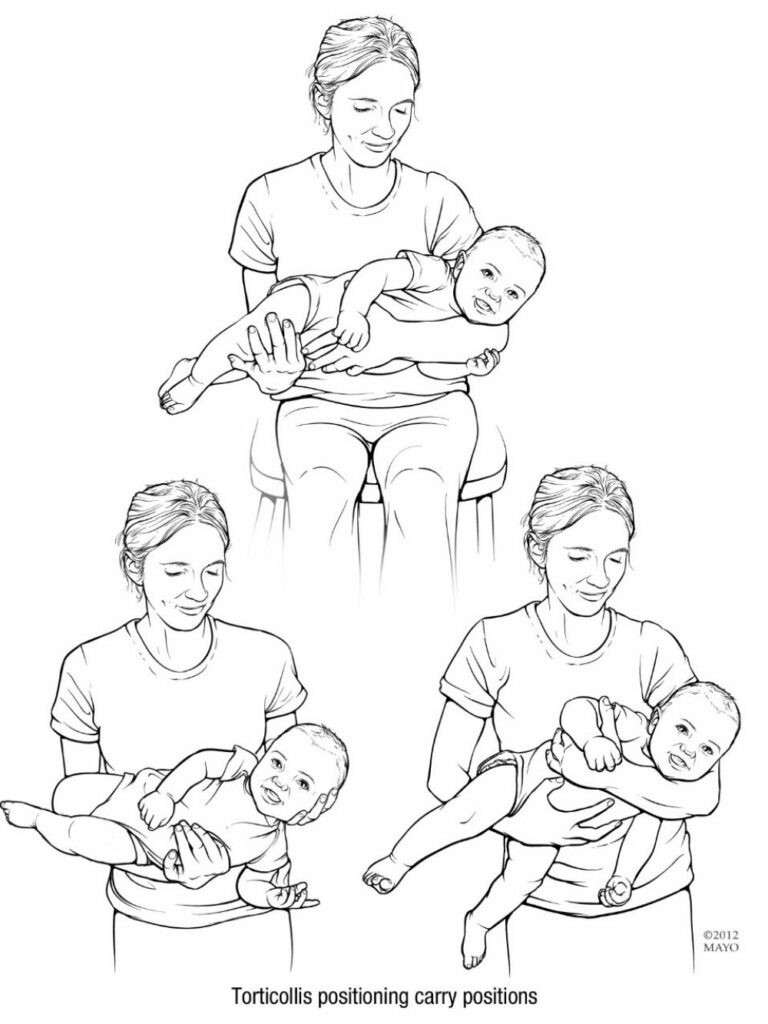
- Carry the baby with their back against the front of holder ‘s body.
- The baby’s head Support with the holder ‘s left arm.
- Holder ‘s right arm give to support of baby’s lower body.
- This position use any time when carry the baby during the day .
Cheek-to-cheek hold :-
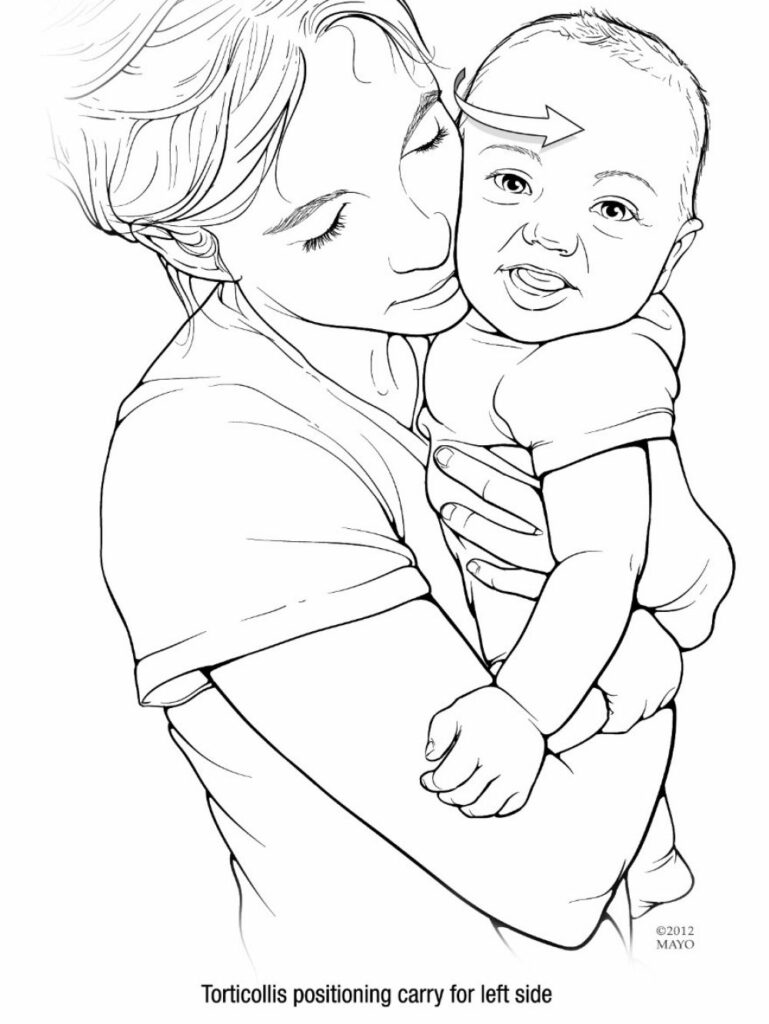
- Hold the baby upright against holder body.
- Gently push holder left cheek against the baby’s right cheek.
- This position help the baby turn to the left.
- Hold up the baby in front of the mirror & see this position in mirror.
- Mirror is use for distract the baby so baby stay in this position.
- Hold the baby in this position during the day.
Feeding positions :-
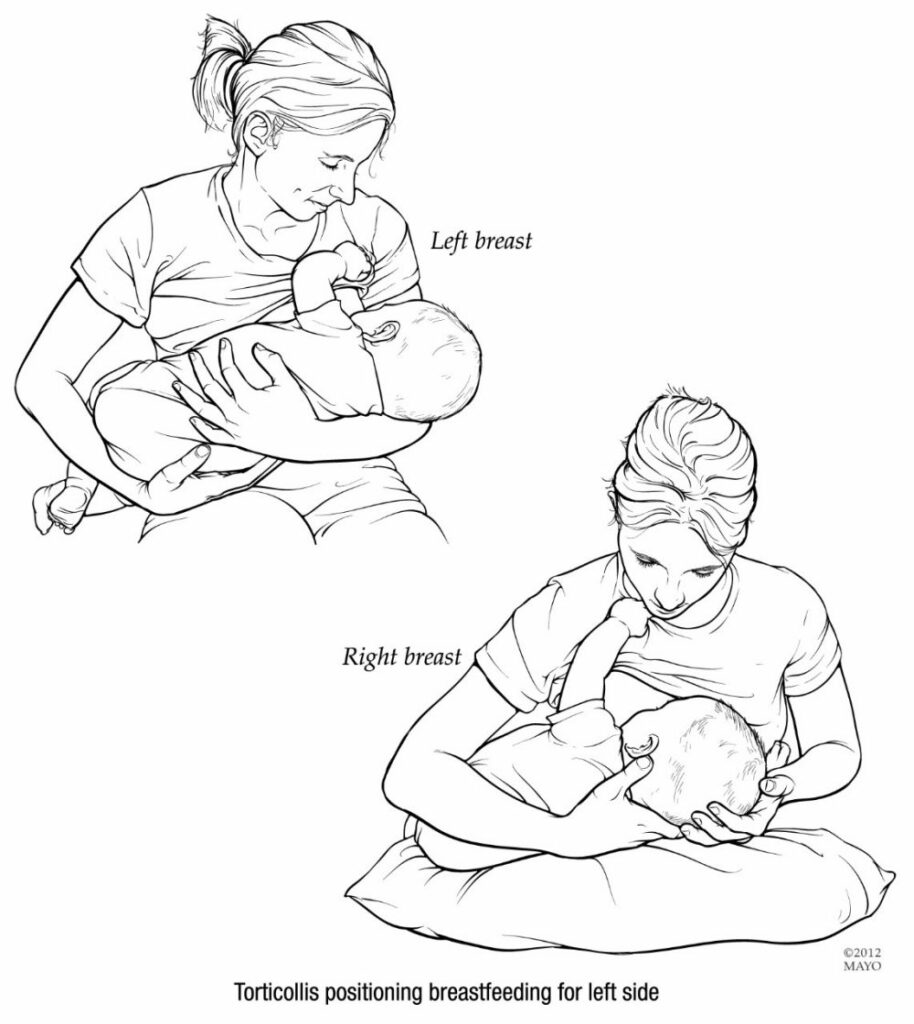
- On the time of feeding such as breastfeeding or by bottle.
- Hold the baby like that baby look to left side.
Exercises for Adult Torticollis :
- Torticollis is become difficult to perform everyday tasks or even turn the neck.
- In most of the cases, exercises and physical therapy of torticollis focus on the muscle tension relieving and strengthening of the muscles which help with posture.
- Those exercises are help to reduce pain and discomfort & as well as help the head to return in a neutral position.
Sensory Trick Training :
- This exercise is a mental exercise which is help to relax stiff neck muscles.
- It is unique aspect of of dystonia is how the muscles react to “sensory tricks.”
- This trick involve use the sense to signal the muscles for release.
- With the torticollis, people find that touch to their face in a certain place for help to the seized neck muscles release.
- In torticollis location of the touch is different for every person .
Forward Head Pulls :
- That stretch is help to release the muscle running up the back and side of the neck.
- It is helpful to torticollis pull the head back or the side.
Step 1: While standing , place the right hand on the back of the head.
The edge of the counter is Hold with the left hand.
Step 2: Slowly turn the head about 45 degrees to the right & then look down.
on that time feel a stretch in the neck and shoulders.
Step 3: If also can, use the right arm to press down on the head to deepen the stretch & Hold for the 40 seconds.
This exercise also perform for to stretch muscles on the other side of the neck.
Opposing Rotations :
- If in the torticollis primarily involve a twist to one side , it is help to stretching and strengthening of the muscle
Step 1: straight Stand and lace the fingers together behind the head & Extend the elbow outward.
Step 2: Slowly turn the head in the direction opposite side of the torticollis &shoulder & arm Keep still.
Step 3: When the feel stretch in the neck, hold the position for30 seconds & then release back in neutral position.
- Repeat the exercise 3 to 5 times per day.
Sideways Head Pulls :
- If the torticollis pull the ear towards the shoulder, this exercise is help the muscle release.
Step 1: therapist Stand next to the counter so that the torticollis can lean to the head towards ear & Hold the counter with the nearest hand.
Step 2: the other hand is place on the top of the head.
Step 3: Lean the head away from the counter, aim is this other ear towards the shoulder.when the feel a gentle stretch on that time use the hand on the head for deepen the stretch. Hold this position for 40 seconds.
- This exercise Repeat 3 to 5 times per day.

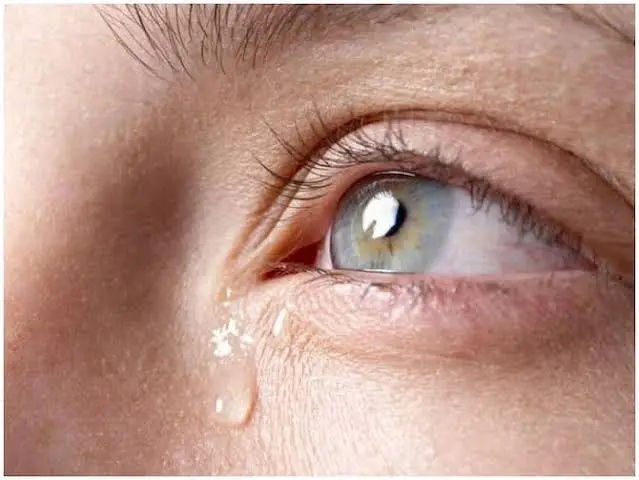
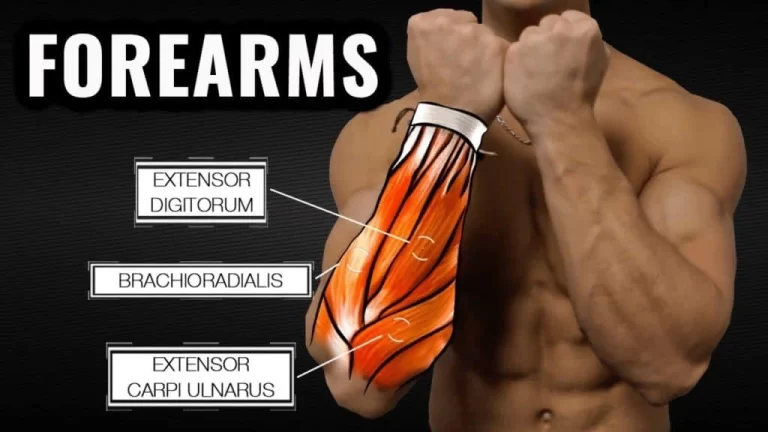
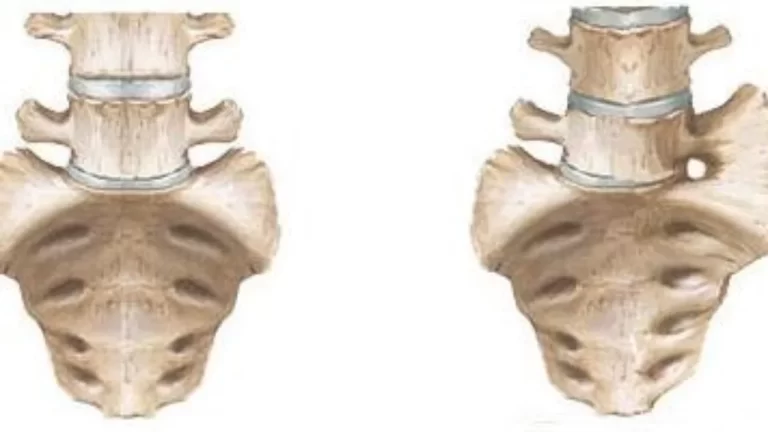
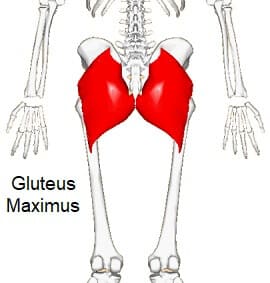
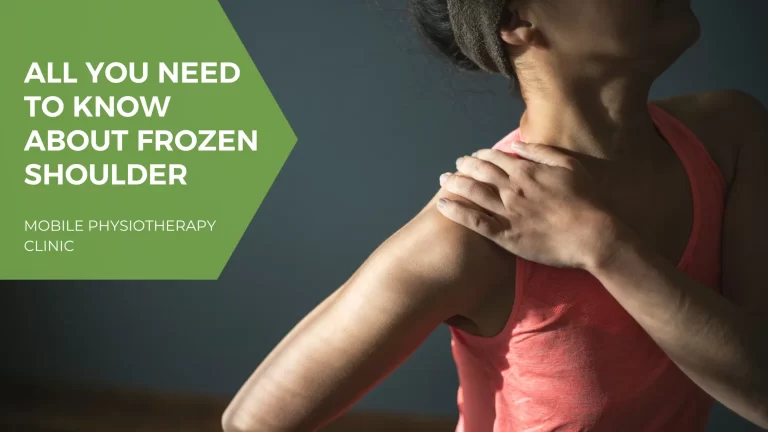

2 Comments